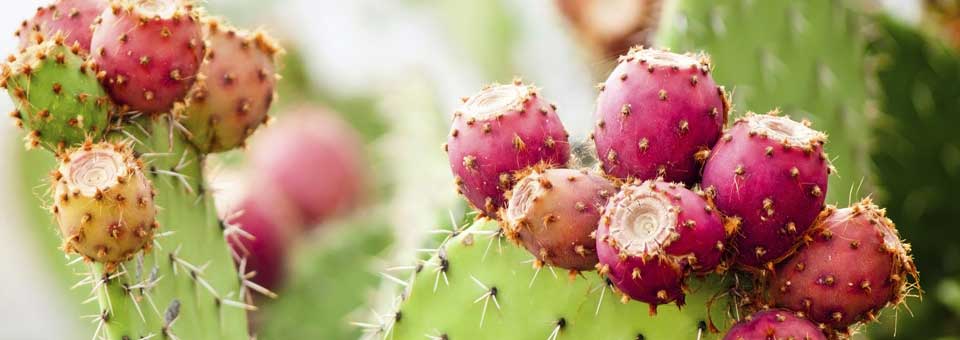
On one of my trips to Jamaica, I saw a beautiful cactus with bright red fruit growing on top. The natives called this spiny shrub the “tuna plant.” I’ve also heard the fruit called “Indian figs.”

In the U.S. we call this plant the prickly pear cactus (Opuntia ficus-indica) or the nopales cactus. It is well-known throughout North and South America, especially in Mexico and the West Indies. Every fall it produces bright red, juicy, tangy fruits known as prickly pears. Some varieties put out fruit that is yellow, light green, orange or pink, depending on the ripeness.
Native healers in Mexico and other countries consider prickly pear a superfood. They use it for treating diabetes and regulating blood sugar. And a study in the Journal of the Academy of Nutrition and Dietetics confirmed the benefits. When 14 patients with type 2 diabetes ate steamed nopales cactus with a meal they significantly reduced blood sugar and insulin spikes. 1
Research also shows it is an effective cancer fighter. In one study, prickly pear juice was tested on cancer cells. The juice reduced the growth of prostate, colon, breast, and liver cancer cells. And it worked without damaging healthy cells.2
Prickly pear has also been used to treat high cholesterol, obesity, colitis, viruses and inflammation. Its health benefits also include its ability to stimulate bone growth, boost the immune system and prevent Alzheimer’s disease. And an extract from the prickly pear even lessens the dry mouth and nausea symptoms of a hangover.
This cactus fruit also provides a huge number of anti-aging benefits for your skin.
Prickly pear is very powerful when it comes to moisturizing and softening skin. You see, the seeds of the fruit are extremely high in essential fatty acids. Oil pressed from prickly pears consists of 60% linoleic acid. This fat is key in stimulating healthy skin cell production and replacing old skin cells. As a result, prickly pear oil soothes even the driest skin and leaves it softer.
Linoleic acid allows the oil to penetrate deep into your skin without leaving a greasy residue. But it also has a low oleic acid content. That makes prickly pear oil non-comedogenic, meaning it will not clog your pores or lead to breakouts.
Prickly pear is also rich in vitamin E, a natural antioxidant and free radical scavenger. It combats cell damage that leads to skin aging. It also supports cell renewal and reduces the look of wrinkles, age spots, and under-eye circles.
One reason prickly pear has so many health benefits is that it has a wealth of antioxidants. These include potent pigments called betalains that have powerful anti-aging effects. In fact, prickly pear has higher levels of these super-antioxidants than other red and purple foods like açai, pomegranate, blueberries, goji berries or beets. The high antioxidant activity of betalains stimulates cell renewal, leaving you with new, glowing skin.
This cactus is also rich in amino acids. These building blocks of protein stimulate collagen production. That helps skin stay firm while it tightens up skin pores for a young fresh look. And studies show it can also reduce the look of scars.3
The oil from prickly pears is great for all skin types and works well to nourish and soothe dry, mature skin. You can also use prickly pear oil as a conditioner to make your hair glossy. And it helps moisturize damaged nails and cuticles.
Prickly pear cactus is easy to grow in your own backyard. Fresh prickly pear fruits are also now showing up in more and more markets.
But be careful — those spines are sharp!
Peel off the prickly parts and then you can eat the fruit raw, boiled or grilled. Or use it to make jellies, jams or juices.
For skin care you can find pure prickly pear seed oil online. But it is not cheap. In fact, it’s one of the most expensive beauty oils in the world. Producing the oil is labor intensive and time-consuming. Seeds are first separated from the fruit and then dried before being cold pressed. And it takes up to 60 pounds of seeds from half a ton of fruit to make just 34 ounces of oil.
To reduce cost, try mixing your prickly pear oil with other ingredients into an anti-aging serum. Here’s an easy recipe:
Anti-Aging Prickly Pear Serum
- 25 ml prickly pear seed oil
- 25 ml sweet almond oil (or jojoba oil)
- 2 drops rose essential oil
- 1 drop lavender essential oil
Combine the oils well and store in a dark dropper bottle. Use as a night serum on face, neck and décolleté. Store in a cool, dark place.
I believe so strongly in the positive effects of prickly pear, I’ve included it in the formula for my new rejuvenating facial mask.
To Your Good Health,
![]()
Al Sears, MD, CNS
1. López-Romero, Patricia et al. “The Effect of Nopal (Opuntia Ficus Indica) on Postprandial Blood Glucose, Incretins, and Antioxidant Activity in Mexican Patients with Type 2 Diabetes after Consumption of Two Different Composition Breakfasts.” Journal of the Academy of Nutrition and Dietetics, 2014, Vol. 114 , Issue 11, 1811-18.
2. R. A. Chavez-Santoscoy, J. A. Gutierrez-Uribe, S. O. Serna-Saldívar. “Phenolic Composition, Antioxidant Capacity and In Vitro Cancer Cell Cytotoxicity of Nine Prickly Pear (Opuntia spp.) Juices.” Plant Foods For Human Nutrition June 2009, Volume 64, Issue 2, pp 146-152.
3. Fang Q, Huang C, You C, Ma S. “Opuntia Extract Reduces Scar Formation in Rabbit Ear Model: A Randomized Controlled Study.” Int J Low Extrem Wounds. 2015 Dec;14(4):343-52.








